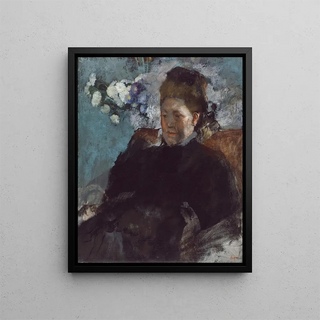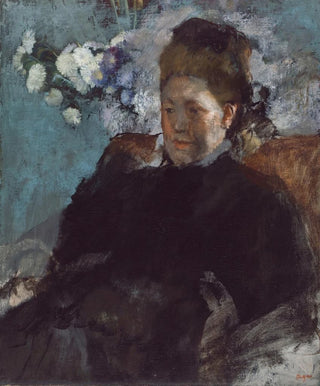Painting Portrait of a Woman - Edgar Degas | Art print


View from behind

Frame (optional)
In the fascinating world of impressionist art, Edgar Degas's "Portrait of a Woman" stands out for its unique approach and emotional depth. This artwork, which captures rare intimacy, immerses us in a fleeting and delicate moment, where the beauty of the woman is highlighted through the artist's penetrating gaze. Degas, known for his ability to seize movement and the instant, manages here to transcend the simple portrait to create a true exploration of human psychology. The art print of this masterpiece invites us to contemplate not only the artist's technique but also the inner universe of his model.
Style and uniqueness of the work
Degas's style in this portrait is characterized by bold use of colors and shapes, creating an atmosphere that is both intimate and dynamic. The composition, although classic in its structure, reveals a striking modernity. The brushstrokes are both fluid and precise, giving the female figure an almost airy lightness. Lighting plays a crucial role, highlighting the delicate features of the face while gently darkening the background, which emphasizes the subject's isolation. The woman, although frozen on the canvas, seems to vibrate with an inner life, inviting the viewer to question her thoughts and emotions. This duality between the tranquility of the pose and the underlying energy is one of Degas's signatures, who knows how to make palpable the soul of his models.
The artist and his influence
Edgar Degas, an emblematic figure of the impressionist movement, knew how to mark his era with an innovative approach to painting. Born in Paris in 1834, he was initially influenced by classical masters before immersing himself in the world of ballet and Parisian life. His interest in movement and the representation of the human body led him to explore various subjects, from dancers to café scenes. Degas always sought to capture the fleeting instant, which allowed him to develop a unique technique that combines realism and abstraction. His influence endures today, inspiring many contemporary artists to explore the complex

Matte finish

View from behind

Frame (optional)
In the fascinating world of impressionist art, Edgar Degas's "Portrait of a Woman" stands out for its unique approach and emotional depth. This artwork, which captures rare intimacy, immerses us in a fleeting and delicate moment, where the beauty of the woman is highlighted through the artist's penetrating gaze. Degas, known for his ability to seize movement and the instant, manages here to transcend the simple portrait to create a true exploration of human psychology. The art print of this masterpiece invites us to contemplate not only the artist's technique but also the inner universe of his model.
Style and uniqueness of the work
Degas's style in this portrait is characterized by bold use of colors and shapes, creating an atmosphere that is both intimate and dynamic. The composition, although classic in its structure, reveals a striking modernity. The brushstrokes are both fluid and precise, giving the female figure an almost airy lightness. Lighting plays a crucial role, highlighting the delicate features of the face while gently darkening the background, which emphasizes the subject's isolation. The woman, although frozen on the canvas, seems to vibrate with an inner life, inviting the viewer to question her thoughts and emotions. This duality between the tranquility of the pose and the underlying energy is one of Degas's signatures, who knows how to make palpable the soul of his models.
The artist and his influence
Edgar Degas, an emblematic figure of the impressionist movement, knew how to mark his era with an innovative approach to painting. Born in Paris in 1834, he was initially influenced by classical masters before immersing himself in the world of ballet and Parisian life. His interest in movement and the representation of the human body led him to explore various subjects, from dancers to café scenes. Degas always sought to capture the fleeting instant, which allowed him to develop a unique technique that combines realism and abstraction. His influence endures today, inspiring many contemporary artists to explore the complex
12,34 €






